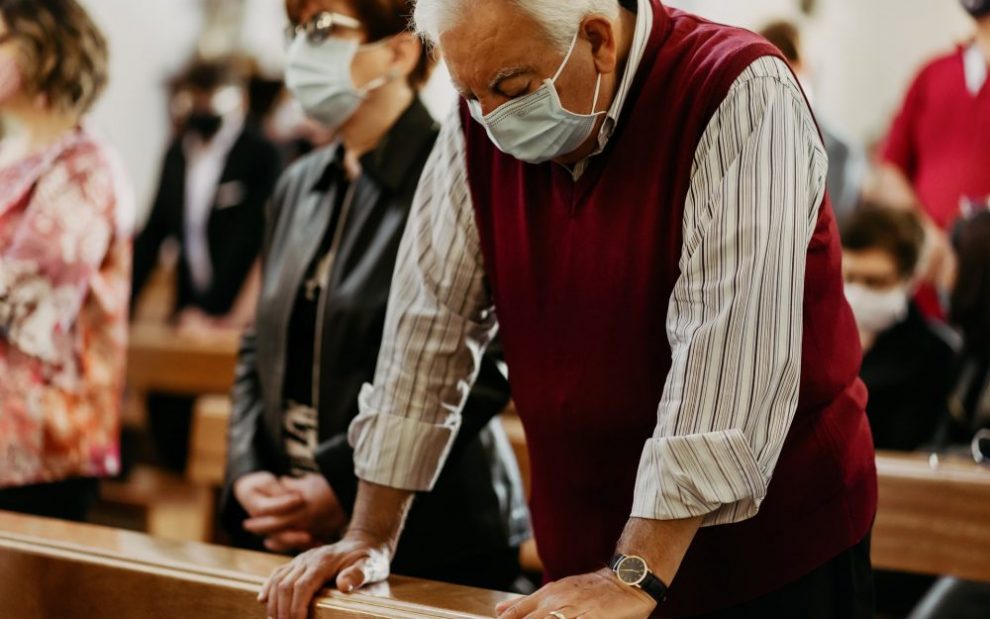Even during the early months of the pandemic, many called the global outbreak of COVID-19 an apocalyptic event. This was not only in the sense that it was a cataclysm that stopped societies in their tracks and cost millions of lives. It was also in the ancient Greek sense of apokálypsis, or a revelation of some great knowledge or truth—not necessarily a pleasant one.
In the United States, this took the form of the fragility of our structures: Lockdowns shattered the job market, eliminating access to health care—more urgently needed than ever—which is overwhelmingly tied to jobs that were now gone. Resistance to social distancing protocols revealed not a pervasive, deferential concern for the well-being of one’s neighbor but a strident, nihilistic libertarianism that called for the weak to be sacrificed for the convenience of the strong.
If this wasn’t instructive enough for religious leaders seeking to form the consciences of believers in their now taped-off pews, the pandemic also revealed that many Americans—Catholics and non-Catholics alike—struggle with how they relate to and talk about religious freedom.
“COVID-19 is just such a perfect prism to tease out where our own individual concerns about religious liberty can run counter to the common good as a whole,” says Stephen Schneck, executive director of Franciscan Action Network in Washington, D.C.
In December 2020, for instance, American Conservative Union Chair Matt Schlapp tweeted in response to new COVID-19 restrictions in Virginia that his governor “has made it illegal for [his] family to sit together at a restaurant. Religious discrimination pure and simple.”
But is it?
“[People] do not have a right to go against the common good,” says Bishop Robert McElroy of the Diocese of San Diego on the idea that it’s a violation if the government tells Catholics they can’t do whatever they want. “That’s not Catholic teaching.”
Religious freedom has been a hot topic in U.S. church debates of the last decade. The Vatican’s International Theological Commission even singled out the topic for study in a 2019 document, “Religious Freedom for the Good of All.” But the pandemic has offered a crash course with debates including limits on public worship, masking requirements, and the morality of the development of certain vaccines. All of it, say bishops, bioethicists, and other Catholic leaders in the public square, betrays a lack of understanding by Catholics about what their own church actually teaches.
“We are ideologically blind, sometimes to the truth . . . because of our desire to see things the way we already think.”
—Bishop W. Shawn McKnight
“We get stuck on the separation of church and state,” says Shawnee Daniels-Sykes, a professor of theology and ethics at Mount Mary University in Milwaukee. “Catechetically, we need to clear that up in terms of what that means.”
“Some of our Catholics adopt a more Protestant or more fundamentalist approach,” says Bishop W. Shawn McKnight of the Diocese of Jefferson City, Missouri. “We are ideologically blind, sometimes to the truth . . . because of our desire to see things the way we already think.”
McElroy, a scholar of John Courtney Murray, the Jesuit who provided the theological groundwork for the Second Vatican Council’s 1965 Dignitatis Humanae (Declaration on Religious Freedom), would like to see the pandemic prompt a recalibration.
“What I would hope would happen is there would be a real discussion and widespread education on what the Catholic concept of religious freedom is,” McElroy says.
Properly understood, this concept has implications for how Catholics understand this freedom as it relates to the common good and how that informs the battles they choose.
Religious freedom and conscience
The first thing McElroy points out about the “first freedom” is that it’s actually made up of a couple different rights, and the first among those, conscience, is inviolable. “What a person of any faith or no faith holds in their conscience about religious teaching is sacrosanct. Government cannot intrude in any way on that,” he says.
“How do you get the answer right? You let people have their God-given right,” concurs Montse Alvarado, vice president and executive director of the Becket Fund for Religious Liberty, a law firm devoted exclusively to litigating religious freedom cases for clients of all religious beliefs. Alvarado contrasts the stakes of Becket’s more recent cases to the 27-year-old firm’s early dedication to the placement of nativity scenes and similar issues.
“It’s so much bigger than that now,” she says. “Now we’re fighting over what we actually believe,” with government interference cropping up in areas such as medical conscience rights and parental school rights. “You’re seeing religious freedom issues there.”
Yet even from this starting point, some U.S. bishops point out the need to delineate between conscience rights and religious freedom.
“She has a right to believe what she believes. But she does not have the right to define Catholic teaching or say something is Catholic teaching when it’s not.”
—Bishop Robert McElroyAdvertisement
“If one has the opinion that vaccines are terrible . . . that doesn’t fly in the state of Missouri,” says McKnight. “It needs to be against one’s religion” to be recognized and protected under state law. “There were pastors in my diocese who were granting a religious exemption for kids in their Catholic schools,” he says. The problem is that church teaching doesn’t support this.
The pandemic offered a high-profile example along these lines when pro-life activist and Catholic convert Abby Johnson declared her intention not to be vaccinated due to the use of fetal stem cell lines in the development of COVID-19 vaccines. When presented with the fact that even the Vatican found the vaccines morally permissible, she disagreed.
“She has a right to believe what she believes. But she does not have the right to define Catholic teaching or say something is Catholic teaching when it’s not,” McElroy says.
As for the question of stem cell lines, McKnight says, “It’s so remote that it does not outweigh the good that is achieved by [the vaccine’s] use.”
Worshipping communities
The second part of religious freedom—the rights of communities of believers—played prominently in the pandemic. Catholic dioceses, including Brooklyn and Washington, D.C., challenged restrictions put in place on their ability to gather for worship.
“If churches aren’t standing up for what they believe, I have no one to defend in court,” says Alvarado. But she also notes that Becket waited three months to file its first lawsuit, giving states the benefit of the doubt to fight the pandemic, which they had a compelling interest to do.
“It’s not like the government is not allowed to do this,” she says, noting that Becket targets restrictions such as capacity limits that are raw numbers rather than percentages, which makes a big difference when a church building is built for thousands of people.
McKnight adds that the church is obliged to follow just laws, not necessarily ideal ones. “We are not completely exempt from living in the world,” he says.
McElroy echoes the need to balance the rights of all religious communities—not just those of Catholics—with the demands of the common good. “It’s not at the level of conscience in itself,” he says. “Religious communities, in their own internal lives and in their lives in the world and their effect on the world as a whole—even as employers and so forth—must [take the common good] into account.”
One can still hunger for the Eucharist without fetishizing it and refrain from public worship without cosplaying persecution.
This is taken directly from Vatican II’s teaching that affirms religious freedom “within due limits,” says Jesuit Father David Hollenbach of Georgetown University.
“You cannot carry out a religious action if it’s going to violate the fundamental human rights of other people. This gets you into a whole set of judgments—practical judgments,” Hollenbach says, about how restrictive one has to be to protect people’s rights to health and life. “You don’t want to violate people’s freedom, unless you want to protect other people from getting the virus and dying from it.”
This runs counter to the message some Catholics spread on social media and other platforms, especially early in the pandemic, trumpeting their participation in underground Masses after their bishops suspended public worship and eschewing masks and social distancing. The performative nature of this, even among the clergy, drew the attention of the Vatican, with the new pro-secretary general of the Synod of Bishops, now Cardinal Mario Grech, telling the Jesuit publication La Civiltà Cattolica these displays had “more to do with magic than an expression of mature faith.”
But one can still hunger for the Eucharist without fetishizing it and refrain from public worship without cosplaying persecution.
“I miss Mass a lot. I really do,” says Schneck. “But I would just be devastated if my going to Mass meant that someone contracts the disease and suffers from it. I just can’t bring myself to take on those responsibilities.”
The common good
The Franciscan Action Network, which operates out of the Franciscan Monastery of the Holy Land in America in Washington, D.C., advocates on social justice concerns for Franciscan communities across the United States. This impulse toward solidarity hit home when the pandemic lockdowns began.
“We were the ones who were going in and out, so we were a risk factor for 40 or so aging friars. It was just so clear to me that we needed to close the office down and get out of there,” says Schneck. The experience of the pandemic since then has sharply contrasted the tribal way Catholics in the United States approach their place in society and the nation’s place in the world.
“In so many ways, this is a resurgence of the old Americanist heresy that Pope Leo XIII condemned,” says Schneck. “I don’t understand the idea that if it doesn’t affect me, it’s all right for me to do something. . . . Conscience doesn’t excuse you from responsibility. Religious liberty is not a get-out-of-jail-free card.”
“Religious liberty is not a get-out-of-jail-free card.”
—Stephen Schneck
“You have even more of an obligation,” McKnight concurs, citing the example of people in his diocese with moral objections to vaccines. “Respecting someone’s conscience isn’t the same thing as overturning or exempting the requirements of the common good.” He recognizes the reality that someone refusing to vaccinate also isn’t masking up. “Typically, it’s the same people. They don’t want to do that either.”
Daniels-Sykes, the only Black Catholic female bioethicist in the United States, finds that the behavior of U.S. Catholics during the pandemic raises uncomfortable questions.
“People have suffered and died,” she says. “How do we allow that type of death and illness to happen?” She notes that widespread refusal to take the pandemic seriously, whether by government officials or her coreligionists, has the undeniable impact of reducing life expectancies in the disproportionately impacted Black and Hispanic communities.
“What does that mean for our faith perspective?” she asks. “It’s a blind spot for us. We have really begun to embrace this whole notion that it’s about me, myself, and I.”
The right to be wrong
For Catholics, the dysfunction of the current moment dates back to Vatican II, the Vietnam War, and the fight over Humanae Vitae (On the Regulation of Birth), says historian Peter Cajka at the University of Notre Dame.
“Catholics live under these two authorities constantly,” he says, and in the case of the fight over reopening churches, “it’s the state telling you that you can’t do what you want to do.” Here, Cajka notes, Catholic bishops are happy to argue against unfettered use of state authority. “But then the hierarchy gives these arguments to laypeople to use against them.”
This is in part because the paradigm shift of Vatican II to proclaim religious freedom a human right abandoned an earlier position that said only Catholics should enjoy religious freedom, a teaching summarized by the slogan “error has no rights.”
“Error does have rights, actually,” says Cajka, citing not only Vatican II but also the preconciliar tradition of the church. “Catholics have these really robust protections for conscience,” protections that apply more for people in conflict with the church than they would for a hierarchy in conflict with civil authorities. “It kind of drags their points down.”
The paradigm shift of Vatican II to proclaim religious freedom a human right abandoned an earlier position that said only Catholics should enjoy religious freedom.
These points include the religious freedom-themed battles of the past decade, which have been championed by businesses such as bakers not wanting to make wedding cakes for same-sex couples and the Little Sisters of the Poor going all the way to the Supreme Court over the issue of including coverage for contraceptives in its employee health plans.
“Making a wedding cake is not forced speech in Catholic teaching. It’s not a helpful concept in terms of understanding Catholic teaching on this question,” McElroy says of the former argument.
As to whether nuns asserting that their religious freedom trumps the conscientious decisions of their employees that is an expression of “error has no rights,” Hollenbach says. He adds, “The Second Vatican Council says everybody’s consciences should be protected” and quotes directly from Dignitatis Humanae: “Even in those who do not live up to their obligation of seeking the truth and adhering to it.”
Future witness
McElroy fears that the idea of religious freedom in the United States has been “victimized by the current partisan split.” He cites how, after the 1990 Supreme Court decision Employment Division v. Smith, authored by Justice Antonin Scalia, overturned a wide religious exemption under the Constitution, Congress easily passed the Religious Freedom Restoration Act. “I don’t know if that would happen today,” he says.
“Trust in religious institutions has dwindled for many reasons,” says Alvarado, including association with power and scandals. “Future generations don’t have that affinity of having been taught by a religious teacher.”
Cajka notes another factor in this dynamic: “Catholics aren’t just political creatures. They’re moral creatures, but they can’t help getting sucked into the politics.”
“People will come to regard an appeal to religious freedom simply as a way to deny other people their freedom,” warns Hollenbach. “If you go to France today, there are very restrictive laws on the practice of religion,” in part because the church sided with the ancien régime during the French Revolution. “There’s a danger we could move in the same direction in the United States. . . . We have to be very careful about how we do that.”
As a sign the United States could move in such a direction, he notes the absence of exemptions for conscience and religion in bills currently before Congress.
“We’ve really just closed ourselves off in terms of opportunities for evangelization.”
—Shawnee Daniels-Sykes
“One thing the church is going to have to deal with is that it’s alienated people in a moment when it shouldn’t have,” says Catholic author and University of California–Berkeley writing professor Kaya Oakes. Noting that institutions and individuals that see their influence dwindling are susceptible to persecution narratives, Oakes says she found it “very difficult to watch” bishops arguing for the reopening of churches while the people getting sick and dying of COVID-19 were people of color who attended Catholic churches.
“They were already kind of limping along in terms of attrition of younger people,” she says. “Are [younger adults] going to want to go back? . . . They already have a distrust of institutions. They already feel that the authority figures don’t care about them.”
“We’ve really just closed ourselves off in terms of opportunities for evangelization,” says Daniels-Sykes. She says the church should learn from how Catholic themes such as love of neighbor and care for the vulnerable guided successful virus mitigation responses in parishes and schools.
She asks: “How come we can’t use those signs and symbols out in the world to help us take care of one another?”
This article also appears in the July 2021 issue of U.S. Catholic (Vol. 86, No. 7, pages 10-14). Click here to subscribe to the magazine.
Image: Unsplash/Gabriella Clare Marino













Add comment